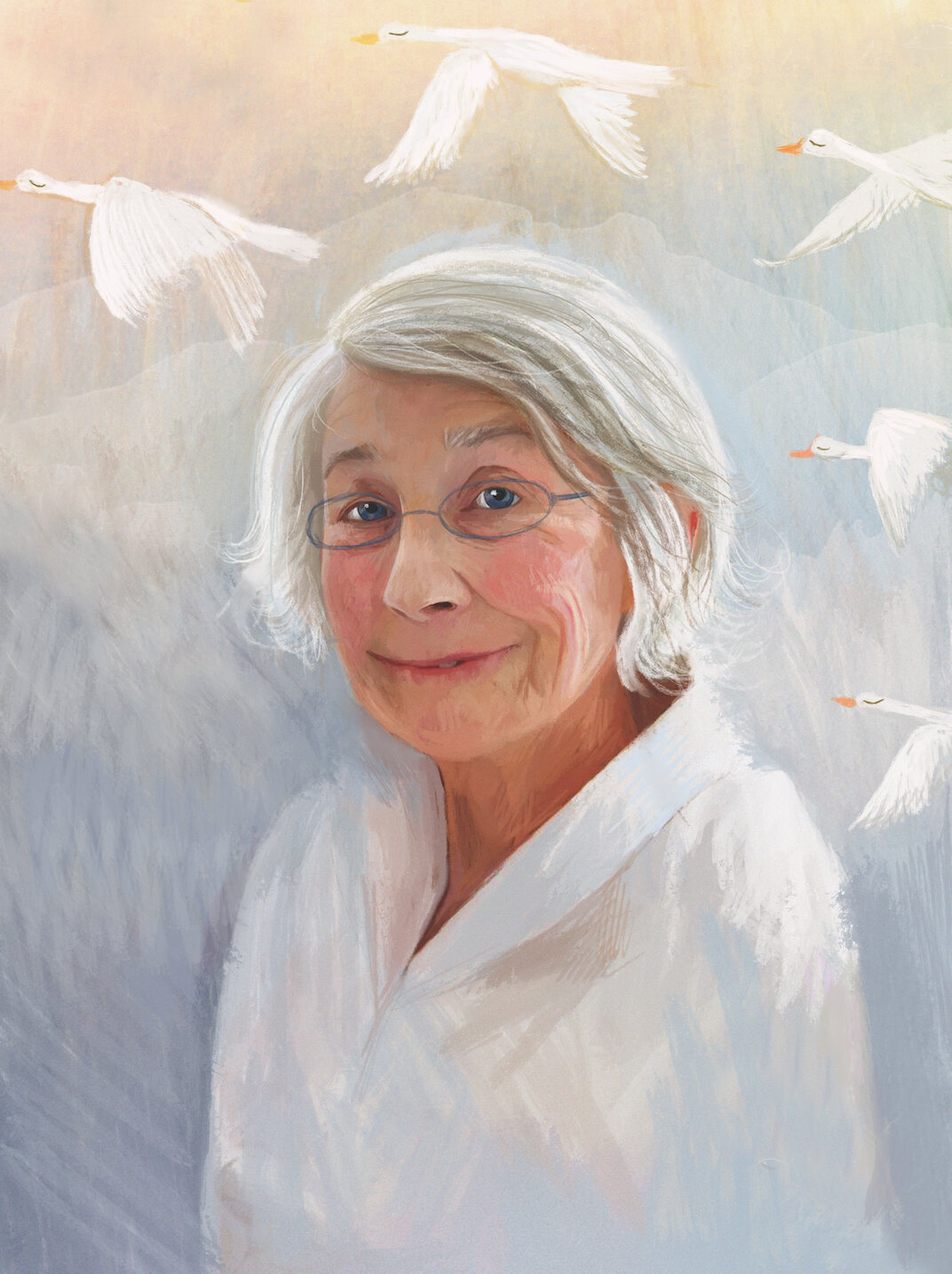The following is a sample profile from the book Holy Troublemakers & Unconventional Saints by Daneen Akers.
Mary Oliver
On a warm summer day in Provincetown, Massachusetts, Mary Oliver sits on the grass with a half-eaten slice of birthday cake on a plate next to her. She is at a birthday party for a friend and is taking a moment to do something she calls, “listening deeply to the world.” You see, Mary is a poet. She pays close attention to the world around her. She always carries a notebook and jots down notes about what she notices. She pays close attention to people, animals, trees, waves, sand, wind, and her own heart. Her poems connect what she sees in the world around her to broader questions that all humans ask about what it means to live a good life.
Today, she notices a grasshopper fling herself onto the plate with the half-eaten birthday cake. Mary hears the faint whir of the grasshopper’s wings as she explores the dessert. The grasshopper gets even closer, drawn by the sweet smell. Soon she eats a little icing from the cake off of Mary’s finger. Mary notices that the grasshopper’s jaws move side to side instead of up and down. She notices how the grasshopper lifts her light green forearm and washes her face, cleaning off the sugary bits. Mary stays perfectly still as the grasshopper opens her wings and floats away.
Illustration by Gillian Gamble.
Mary quickly scribbles some notes about what she has just seen. She is completely absorbed thinking about the grasshopper and misses part of the birthday party. But this is Mary’s calling, what she is meant to do. She knows she has to pay attention to what she sees. Not everything she notices becomes a poem, and sometimes the finished poems aren’t very good. But she writes them anyway because she knows that this is how she takes care of that voice inside of her that compels her to write poetry.
Sometimes the poems that emerge from her notes are so beautiful that people all over the world feel like they’ve been right there with her noticing the grasshopper eating sugar off of her finger on a warm summer day. When Mary asks the readers of the poem what they are going to do with their one “wild and precious life,” they feel something wonderful rise up inside of their own bodies in response. That’s the magic that happens when we read a poem that speaks to us, we feel like we are right there too, asking ourselves the same questions.
That particular poem that Mary wrote watching that grasshopper is called, “The Summer Day,” and it’s one of Mary Oliver’s most famous poems. People all over the world love it and credit it with helping them.
The Summer Day
Who made the world?
Who made the swan, and the black bear?
Who made the grasshopper?
This grasshopper, I mean—
the one who has flung herself out of the grass,
the one who is eating sugar out of my hand,
who is moving her jaws back and forth instead of up and down—
who is gazing around with her enormous and complicated eyes.
Now she lifts her pale forearms and thoroughly washes her face.
Now she snaps her wings open, and floats away.
I don’t know exactly what a prayer is.
I do know how to pay attention,
how to fall down into the grass,
how to kneel down in the grass,
how to be idle and blessed,
how to stroll through the fields,
which is what I have been doing all day.
Tell me, what else should I have done?
Doesn’t everything die at last, and too soon?
Tell me, what is it you plan to do
with your one wild and precious life?
Mary said that poetry saved her life. Mary had a very difficult childhood in a small town in Ohio. Her father was abusive, and her mother neglected her. To escape her deeply unhappy house, Mary began taking long walks in the woods. She’d put a poetry book in her backpack and head out for the day. She loved being in motion, and she began walking and reading poets like Walt Whitman, Ralph Waldo Emerson, Edna St. Vincent Millay, and Henry David Thoreau. All of those poets also loved being outside and paying attention to the natural world. “The old dead poets were my friends,” she said. “I saved my own life by finding a place for myself that wasn’t in that house.”
Gradually Mary began writing while she walked. “My first poems were terrible,” she says. “But I kept at it.” Eventually, her poems started to improve. She never wanted to be a poet with complicated words and symbols that only other poets could figure out. She thought a simple and direct style of writing best matched what she wanted to say.
Mary left home at 17, desperate to be away from her unhappy home. She met other people who loved poetry, too, and, within a few years, she had published her first book of poetry. Although her life was extremely hard, she focused most of her poetry on the things that brought her joy and gratitude.
When Mary was in her late 20s, she met the love of her life, Molly Malone Cook, a photographer and art gallery owner.Together they lived in Provincetown, Massachusetts for over 40 years. Mary kept writing poems that were inspired by her walks through Provincetown and the shores of the Atlantic, noticing the ocean, the woods, and the animals and birds that call the natural world home.
In the beginning, Mary wasn’t just looking for inspiration for her poetry as she walked and walked all around Provincetown—she was also foraging for food. She was very poor for years before her poetry books began to sell well, and she often went out to find mushrooms in the woods or to dig up clams along the seashore.
Her fascination with mystery and the wonders of the world continually gave Mary new reasons to keep loving a walk in the woods with her notebook and pencil. As usual, her job was to pay attention to what she saw, heard, and felt. For Mary, a walk in the woods listening deeply could be a type of prayer. “Attention is the beginning of devotion,” she wrote.
Mary’s poems often touch on spiritual topics like God and prayer, even though Mary rarely talked much about churches, official beliefs, or other things people often associate with religion. She became an unconventional spiritual teacher for many people today because she wrote a lot about God, what might come after death, and the questions all humans face about why we are here. “We all wonder about God,” Mary said. “Who is God? What’s going to happen when we die?”
Until her death in 2019, Mary came back to that theme often in her poems as she observed the infinite cycles of life, death, and rebirth—resurrection even—in the natural world that she loved so much. She said that while what happens after death is ultimately a mystery, she strongly believed something did. “It’s not nothing,” she said. “It’s an endless, unanswerable quest, but I find it fascinating.”
Take a moment, right now, to notice something.
What details do you notice when you really focus your attention?
Might you write a poem about it?
Glossary Terms
Called/Calling
The sense that God, or a messenger of God, has specifically assigned a person a certain job; often applied in religious job settings, such as, “I was called to become a minister.”
Spiritual
Something that relates to the human soul or spirit.
Unconventional
Not thinking the same way or behaving like most other people around you; having new, fresh ideas.
Read another sample chapter from the Holy Troublemakers & Unconventional Saints book by Daneen Akers.



